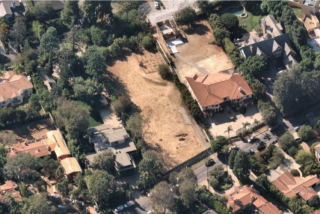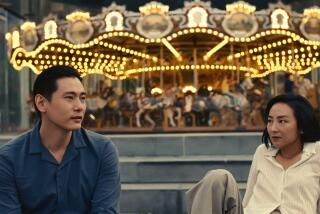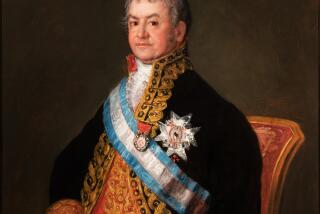Huntington Library President Steven Koblik leaves with sense of pride
- Share via
Even in the home stretch of his 14-year run as president of the Huntington Library, Art Collections and Botanical Gardens, Steven Koblik was still learning on the job.
Recently leading a visitor on a tour of some of his favorite things on the 207-acre spread in San Marino, Koblik began with the reading room where scholars writing books come from around the world to comb through manuscripts and rare books from the Huntington’s huge collections.
The sculpted heads of Benjamin Franklin, Abraham Lincoln, Joseph Conrad, Dante Alighieri and other great authors and statesmen whose papers and rare editions reside at the Huntington looked down on readers from arched perches above the bookshelves.
Keeping his usually exuberant voice down in deference to the researchers, Koblik nodded to the carved visage of Richard Francis Burton, who scandalized Victorian England with his unexpurgated translations of “The Arabian Nights” and the Kama Sutra.
“We have a great collection of Burton,” Koblik said. “The guy was a madman.”
Then something about the heads dawned on him. “The writers are on one side and the politicians are on the other. I’d never noticed before. You can work here 40 years and discover new things.”
When he retires Tuesday at 72, the campus Koblik leaves to his successor, Pitzer College president Laura Trombley, will be full of things that weren’t there when he arrived: 277,000 square feet of new or renovated buildings, 20 acres of new or restored gardens and expanded collections that now include books of coded telegraph messages from the front lines to President Lincoln during the Civil War and a massive trove of books and manuscripts on the history of science.
Koblik has been a powerful fundraiser. On his watch, the Huntington received $636 million in cash donations and saw its endowment nearly triple to $480 million. It spent $168 million on construction and renovations without taking on debt — yielding, among other things, a Chinese garden, the Munger Research Center, which houses the library collection, and the Erburu Gallery for American art. The operating budget doubled to $56 million.
“It’s been an explosion of vitality,” said Selma Holo, director of USC’s Fisher Museum of Art. She said the Huntington under Koblik contrasts wildly with the institution she first encountered decades ago. “You had a kind of specialists’ retreat, and now the whole region is welcomed by the diversity of the offerings.”
Koblik said his first project set the tone: fixing up the aging mansion where railroad and development baron Henry Huntington lived until his death in 1927, leaving the buildings, gardens, books and art for scholars to use and Angelenos to enjoy.
The last new buildings on Koblik’s watch opened this year and are named for him: an entrance pavilion that includes a large bookstore, cafe, classrooms, a 380-seat auditorium and 28,000 square feet of underground storage for the library’s ever-expanding collections.
Koblik loves to pepper his conversation with quips, and he says he made sure running the Huntington didn’t stop him from having fun. As a manager, he said, “I’m playful but serious. A little needling goes a long way, and I like to laugh.”
He grew up in Sacramento, the son of an architect and grandson of Russian-Jewish leftists who agitated against the czar until they were forced to flee to San Francisco in 1905. There, Koblik says proudly, they picked up where they had left off — “trying to foment revolution and active in radical and pacifist politics until the time they died.”
Koblik first experienced the Huntington in 1968 as a recently arrived professor of Swedish history and international politics at Pomona College.
“I had a mustache like Pancho Villa and hair that stuck out in all directions,” he recalled. He was greeted by historian Ray Billington, one of the Huntington’s most eminent in-house scholars, with the words “Steve, we don’t let people like you in the library.”
“Ray was a big jokester,” Koblik said.
Koblik veered from scholarship to administration in the late 1980s as dean of the faculty of Scripps College, which he said was mired in academic rivalries compounded by fiscal woes. Then Reed College in Portland, Ore., summoned him to be its president — another small liberal-arts school where the finances were bad and the faculty’s mood was sour.
“No one ever hires me until they’ve panicked,” Koblik joked. His way of overcoming panic was to cultivate the kinds of donations that can assuage institutional nerves.
At the Huntington he won over Charles Munger, Warren Buffett’s right-hand man at Berkshire Hathaway and now the third-most-generous donor in its history after Henry Huntington and Frances Brody, an art collector and philanthropist who died in 2009, bequeathing $123 million.
Munger gave $21 million for the research center and $32 million for the new entrance buildings, figuring he could count on Koblik to get them right.
“He just had a forceful, pleasant personality and had accomplished a lot,” Munger said, recalling his first impression. Now, he said, “I just hate it that he’s retiring. The new person may be wonderful, but Steve is as good at running the Huntington as Warren Buffett is at running Berkshire Hathaway. He has a lot of savvy for an academic.”
Koblik credits his predecessor, Robert Skotheim, with laying the groundwork for the Huntington’s success by reversing its financial decline and ending its long-standing indifference to attracting and serving the public.
After retiring to Washington state, Skotheim stayed in close touch to see what would happen next. Under Koblik, attendance soared to about 600,000 a year — all but maxing out what the Huntington can accommodate because the city of San Marino restricts the number of cars that can enter.
“The reclusive Pasadena [area] institution with its fabled anti-Semitism became a leader in all sorts of ways intellectually and ethnically,” Skotheim said. “You now have subversive feminists, political radicals and all kinds of critics of the status quo studying the material that Henry Huntington purchased, and it’s all being financed to this day by wealthy Americans. The irony is quite delicious.”
Koblik has kept a fairly low profile, working behind the scenes instead of chasing headlines, cultivating donors instead of the press.
“Fundraising is about relationships and [conveying] what’s important to the institution,” he said. “My job is to get to know people and know what they think is important, play around in my mind what the Huntington needs, and see if there is any commonality.”
There was no courting the strong-willed Brody, Koblik said. She was a staunch longtime backer of the Huntington who especially loved its gardens. Koblik said he never proposed a sum — he usually doesn’t — and that it would have been useless anyway.
He did recall suggesting to Brody that, since the Huntington focuses on British and American art, she consider giving prime works from her collection of European Modernists to the Los Angeles County Museum of Art, where she and her late husband, Sidney, were longtime supporters.
“She said no, and if you knew Frances Brody, that was the end of the conversation,” Koblik said. “I and others at the Huntington were over to her house a lot, but there were no numbers mentioned.” Brody’s will specified that her home and most of her art should be sold, with the Huntington receiving a large share of the proceeds. The Huntington didn’t know before her death how much it would receive; Koblik told the Chronicle of Philanthropy in 2010 that the windfall was “a brilliant accident.” LACMA got a lovely ceramic mural by Matisse that had graced Brody’s patio.
James Folsom, the Huntington’s director of botanical gardens since the 1980s, said one of Koblik’s most important decisions was enthusiastically supporting the costliest way possible to create a Chinese garden. The Huntington commissioned scores of scholars and artisans in China to design it, build its structures, and cull limestone deposits that look like sculptures from underwater formations in a Chinese lake. Then they came to San Marino to oversee installation.
Koblik and Folsom went to the world’s best experts because they wanted the garden to fully embody the symbolism, harmonies and shifting perspectives that are hallmarks of a centuries-old tradition.
“We knew how disappointing it would be for the Chinese American community to find out we kind of faked it instead of doing it as it’s done in China,” Folsom said. That community donated heavily to the project and Koblik said that local Chinese now account for more than a quarter of the Huntington’s 38,000 members. Trombley’s agenda will include raising about $9 million needed to carry out a final construction phase that will increase the Chinese garden to 12 acres.
After nearly 14 years of living in a stately guest house on the Huntington’s grounds — a requirement as well as a perk — Koblik and his Swedish-born wife, Kirsten, will move back to the modest home in Claremont where they lived when he was a professor. They raised their son and daughter there, and more children — brain-children, that is — may be on the way.
Koblik is working on a history of small northern European countries since World War II, tentatively called “Embracing Democracy.” After that, he’ll decide whether to tackle an insider’s history of the Huntington.
Some people at the Huntington think its worst moment under Koblik may have been his finest. With the endowment plummeting in the market meltdown of 2008-09, he had to lay off some employees and cut pay for all who remained. But it was done on a sliding scale of 3% to 10% to protect lower-paid workers, and all had a choice whether to have it taken out of their pay or their retirement benefits.
When Koblik called the staff together to deliver the bad news, “one of the most remarkable things happened,” said David Zeidberg, longtime director of the library division. “There was applause, because they recognized he had made a genuine effort” to be fair and give everyone the dignity of choice.
Koblik remembers it a little differently. It wasn’t just applause, he said. “I got a standing ovation.”
Unlike the reading room, the Chinese garden and other spots that most signify his years at the Huntington, Koblik can’t show a visitor where this happened. The meeting hall is gone. The Steven S. Koblik Education and Visitors Center stands in its place.
mike [email protected]
More to Read
The biggest entertainment stories
Get our big stories about Hollywood, film, television, music, arts, culture and more right in your inbox as soon as they publish.
You may occasionally receive promotional content from the Los Angeles Times.











